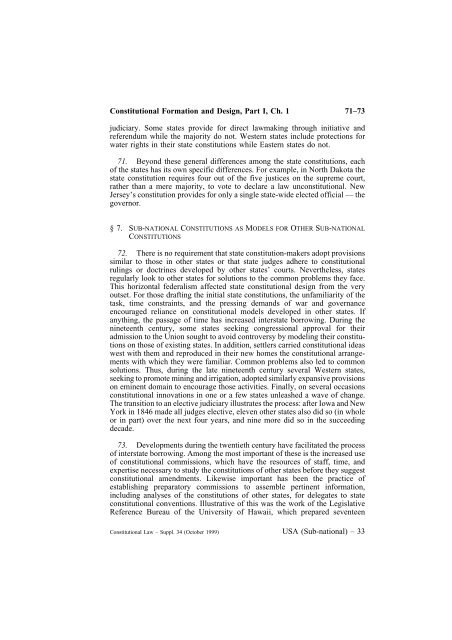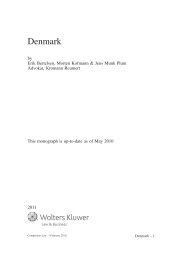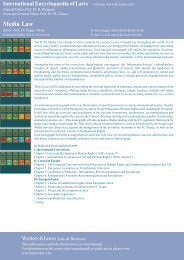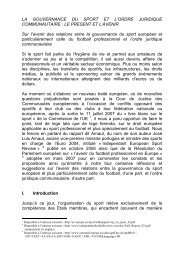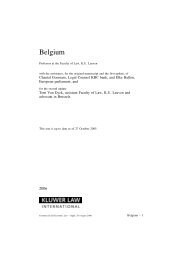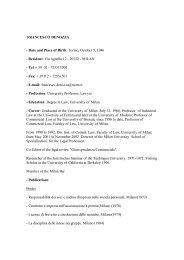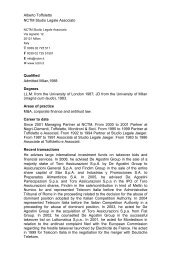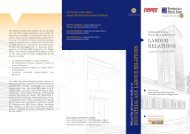69–70 Part I, Ch. 1, Constitutional Formation and Design– such as protections <strong>of</strong> rights, popular rule, a separation <strong>of</strong> powers, and anindependent judiciary – are likewise found in state constitutions; so when a newstate constitution incorporates these features, it is difficult to determine whetherthe federal Constitution or its state counterparts provided the model. Even thepresence <strong>of</strong> textual similarities between the federal Constitution and subsequentstate constitutions is not determinative. In some instances federal constitutionmakersderived their formulations from earlier state charters, and these ratherthan the federal document may have guided later state constitution-makers aswell. Notwithstanding these obstacles to precision, in some instances the federalinfluence is unmistakable. Immediate emulation <strong>of</strong> the federal model reveals thedirect federal influence. For example, Pennsylvania, Delaware, New Hampshire,and Kentucky all adopted the federal mode <strong>of</strong> judicial selection within a decadeafter the Constitution was ratified. Distinctive federal language may alsoreappear in state charters. For example, twenty-three states have adoptedlanguage patterned after the freedom <strong>of</strong> speech and press provisions <strong>of</strong> the FirstAmendment; twelve have equal protection clauses similar to the FourteenthAmendment’s; and eleven prohibit religious establishments in terms comparableto the First Amendment’s establishment clause. In fact, in at least one instance,state constitution-makers modelled their provisions on a federal provision thatfailed <strong>of</strong> adoption. From 1968 to 1976, at the same time that the equal rightsamendment to the federal Constitution (guaranteeing gender equality) was underconsideration, fourteen states adopted their own ‘little ERA’s.’ The language<strong>of</strong> these provisions tracks the federal amendment, and their legislative historiesreveal a desire to provide comparable protections in the state and federaldocuments. 11. For a listing <strong>of</strong> provisions and an account <strong>of</strong> their genesis, see G. Alan Tarr and MaryCornelia Porter, ‘Gender Equality and Judicial Federalism: The Role <strong>of</strong> State AppellateCourts,’ Hastings Constitutional Law Quarterly 9 (1982) 919–973.§6. SIMILARITIES AND DIFFERENCES AMONG SUB-NATIONAL CONSTITUTIONS69. All <strong>of</strong> the American state constitutions follow the same basic structuralpattern, but there is a wide variety <strong>of</strong> difference in the details. For example,each state has a Declaration, or Bill <strong>of</strong> Rights. There are standard provisions,such as free speech, protection against unlawful search and seizure, right tocounsel in criminal cases, and protection against deprivation <strong>of</strong> private propertywithout compensation that appear in virtually all <strong>of</strong> the state Bills <strong>of</strong> Rights. Onthe other hand, guarantees <strong>of</strong> equal rights for women and people with disabilities,protections for organized labor, and rights to privacy, to name a fewexamples, appear in only some <strong>of</strong> the states’ Bills <strong>of</strong> Rights.70. With respect to government structure, the state constitutions reflectbasic similarities, but also a wide range <strong>of</strong> differences in detail. For example,some states have only a single chief executive, while others have a number <strong>of</strong>state executive <strong>of</strong>ficials provided for in their constitutions. Some states providefor elected judges in their constitutions, while others utilize an appointed32 – <strong>USA</strong> (Sub-national) Constitutional Law – Suppl. 34 (October 1999)
Constitutional Formation and Design, Part I, Ch. 1 71–73judiciary. Some states provide for direct lawmaking through initiative andreferendum while the majority do not. Western states include protections forwater rights in their state constitutions while Eastern states do not.71. Beyond these general differences among the state constitutions, each<strong>of</strong> the states has its own specific differences. For example, in North Dakota thestate constitution requires four out <strong>of</strong> the five justices on the supreme court,rather than a mere majority, to vote to declare a law unconstitutional. NewJersey’s constitution provides for only a single state-wide elected <strong>of</strong>ficial — thegovernor.§7. SUB-NATIONAL CONSTITUTIONS AS MODELS FOR OTHER SUB-NATIONALCONSTITUTIONS72. There is no requirement that state constitution-makers adopt provisionssimilar to those in other states or that state judges adhere to constitutionalrulings or doctrines developed by other states’ courts. Nevertheless, statesregularly look to other states for solutions to the common problems they face.This horizontal federalism affected state constitutional design from the veryoutset. For those drafting the initial state constitutions, the unfamiliarity <strong>of</strong> thetask, time constraints, and the pressing demands <strong>of</strong> war and governanceencouraged reliance on constitutional models developed in other states. Ifanything, the passage <strong>of</strong> time has increased interstate borrowing. During thenineteenth century, some states seeking congressional approval for theiradmission to the Union sought to avoid controversy by modeling their constitutionson those <strong>of</strong> existing states. In addition, settlers carried constitutional ideaswest with them and reproduced in their new homes the constitutional arrangementswith which they were familiar. Common problems also led to commonsolutions. Thus, during the late nineteenth century several Western states,seeking to promote mining and irrigation, adopted similarly expansive provisionson eminent domain to encourage those activities. Finally, on several occasionsconstitutional innovations in one or a few states unleashed a wave <strong>of</strong> change.The transition to an elective judiciary illustrates the process: after Iowa and NewYork in 1846 made all judges elective, eleven other states also did so (in wholeor in part) over the next four years, and nine more did so in the succeedingdecade.73. Developments during the twentieth century have facilitated the process<strong>of</strong> interstate borrowing. Among the most important <strong>of</strong> these is the increased use<strong>of</strong> constitutional commissions, which have the resources <strong>of</strong> staff, time, andexpertise necessary to study the constitutions <strong>of</strong> other states before they suggestconstitutional amendments. Likewise important has been the practice <strong>of</strong>establishing preparatory commissions to assemble pertinent information,including analyses <strong>of</strong> the constitutions <strong>of</strong> other states, for delegates to stateconstitutional conventions. Illustrative <strong>of</strong> this was the work <strong>of</strong> the LegislativeReference Bureau <strong>of</strong> the University <strong>of</strong> Hawaii, which prepared seventeenConstitutional Law – Suppl. 34 (October 1999) <strong>USA</strong> (Sub-national) – 33
- Page 1 and 2: United States of AmericaSub-nationa
- Page 3 and 4: The AuthorsG. Alan Tarr is Distingu
- Page 5 and 6: Table of ContentsThe Authors 3Gener
- Page 7 and 8: Table of Contents§ 2. Political Pa
- Page 9 and 10: General Introduction1§1. THE SUB-N
- Page 11 and 12: General Introduction 2-6§2. TYPES
- Page 14 and 15: 14-19 General Introductionofficials
- Page 16 and 17: 24-28 General Introductioning text
- Page 18 and 19: 36-39 General IntroductionOlder loc
- Page 20 and 21: General Introduction20 - USA (Sub-n
- Page 22 and 23: 43-47 Selected BibliographyRobert F
- Page 24 and 25: Selected Bibliography24 - USA (Sub-
- Page 26 and 27: 52-53 Part I, Ch. 1, Constitutional
- Page 28 and 29: 56-57 Part I, Ch. 1, Constitutional
- Page 30 and 31: 60-63 Part I, Ch. 1, Constitutional
- Page 34 and 35: 74-76 Part I, Ch. 1, Constitutional
- Page 36 and 37: 80-83 Part I, Ch. 1, Constitutional
- Page 38 and 39: 86 Part I, Ch. 1, Constitutional Fo
- Page 40 and 41: 125-127 Part II, Ch. 1, Generallegi
- Page 42 and 43: 129Chapter 2. Head of the Sub-natio
- Page 44 and 45: 135-138 Part II, Ch. 3, The Legisla
- Page 46 and 47: 143-145 Part II, Ch. 3, The Legisla
- Page 48 and 49: 150-153 Part II, Ch. 3, The Legisla
- Page 50 and 51: 185 Part III, Ch. 1, Sub-national C
- Page 52 and 53: 191-197 Part III, Ch. 2, Fundamenta
- Page 54 and 55: 203-205 Part III, Ch. 2, Fundamenta
- Page 56 and 57: 209-212Chapter 4. Judicial Control
- Page 58 and 59: Part III, Ch. 5, Legal Position of
- Page 60 and 61: 216-218Chapter 2. Constitutional St
- Page 62 and 63: 223-224 Part IV, Ch. 3, Evolution o
- Page 64 and 65: Illinois ConstitutionSection 5. Rig
- Page 66 and 67: Illinois ConstitutionSection 16. Ex
- Page 68 and 69: Illinois ConstitutionArticle IV - T
- Page 70 and 71: Illinois Constitutionmembers electe
- Page 72: Illinois ConstitutionSection 12. Le
- Page 75 and 76: Illinois ConstitutionSection 16. Se
- Page 77 and 78: Illinois ConstitutionSection 8. Ass
- Page 79 and 80: Illinois Constitution(e)(f)(g)are J
- Page 81 and 82: Illinois Constitution(d)(e)treasure
- Page 83 and 84:
Illinois Constitutiongovernmental s
- Page 85 and 86:
Illinois ConstitutionSection 2. Non
- Page 87 and 88:
Illinois Constitution(c)(d)(e)(f)gu
- Page 89 and 90:
Illinois Constitutioncandidates for
- Page 91 and 92:
Illinois Constitutionfiled with the
- Page 93 and 94:
IndexThe numbers given are paragrap


